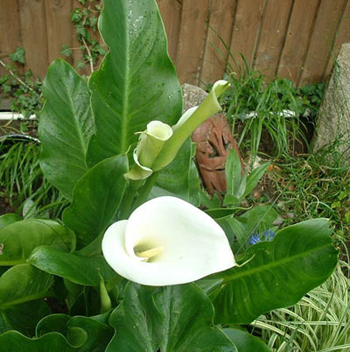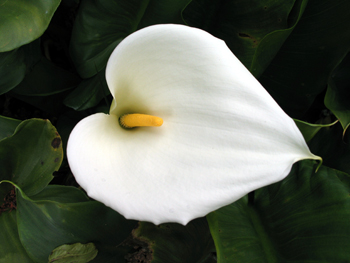Contents:
Common Names | Parts Usually Used | Plant(s) & Culture | Where Found | Medicinal Properties
Uses | Warning | Bibliography
Scientific Names

- Arum maculatum L.
- Arum family
Common Names
- Cocky baby
- Cuckoopint
- Cypress powder
- Dragon root
- Gaglee
- Ladysmock
- Portland arrowroot
- Starchwort
Parts Usually Used
Rootstock
Back to Top
Description of Plant(s) and Culture

Arum is a perennial plant; its tuberous rootstock is poison when fresh but edible when dried or sufficiently cooked. It is about the size of a walnut and is brown outside, white inside. Arum’s arrowhead-shaped leaves are also poisonous when eaten. Its flowers, which bloom in May and June, trap insects which the plant digests for food.
Other varieties: Wake robin or Jack in the pulpit (A. triphyllum); Dragon or Green arum (A. dracontium)
Back to Top
Where Found
It grows in moist, shady places, along hedges, among bushes, and in deciduous forests.
Back to Top
Medicinal Properties
Acrid when fresh, diaphoretic, expectorant
Back to Top
Uses
Only the dried root should be used.
Arum is used mixed with honey or syrup for internal use and as an ointment for external use. Internally, used for bronchitis, asthma, chronic catarrh, flatulence, and rheumatic problems. A 1:1 mixture of arum and sweet flag in powder form is sometimes recommended as a stomachic. An ointment made from arum is useful for sores and ringworm, swellings. Simmer arum with cumin in wine or oil to make a plaster. Only the dried root should be used.
Back to Top
Warning
The whole plant of arum is poisonous. Only the root, dried and/or sufficiently cooked, should be used. Recommended use of arum only under medical supervision.
Back to Top
Bibliography
![]() Eastern/Central Medicinal Plants
Eastern/Central Medicinal Plants, by Steven Foster and James A. Duke., Houghton Mifflin Company, 215 Park Avenue South, New York, NY 10000
![]() The Herb Book
The Herb Book, by John Lust, Bantam Books, 666 Fifth Avenue, New York, NY. copyright 1974.
![]() Indian Herbalogy of North America
Indian Herbalogy of North America, by Alma R. Hutchens, Shambala Publications, Inc., Horticultural Hall, 300 Massachusetts Avenue, Boston, Massachusetts 02115, 1973
![]() Webster’s New World Dictionary
Webster’s New World Dictionary, Third College Edition, Victoria Neufeldt, Editor in Chief, New World Dictionaries: A Division of Simon & Schuster, Inc., 15 Columbus Circle, New York, NY 10023
